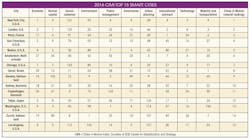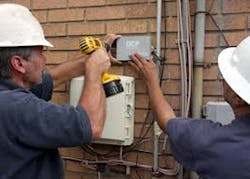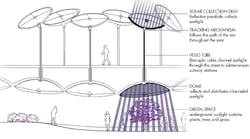Download this article as a .PDF
The goal of smart cities is to improve the quality of life for its citizens through technological means, ultimately creating more sustainable cities. It is a team effort that requires many sectors of a society to safely and strategically integrate technology, information, and data solutions.
The vision of a smart city might differ for citizens living in different geographical locations, because every city has its own challenges and needs. Some of these diverse challenges include density of the population, infrastructure, topography, transportation systems, waste-management programs, or even the disposition of the local government and private business of investing money to create smart-city initiatives.
Sponsored Asset:
Enable smarter, safer, cleaner cities
Smart cities are based on intelligent sensors. Data from those sensors is pulled and processed to create innovative programs or solutions associated with everyday aspects of city life, such as energy, utilities, urban mobility, public safety, air quality, waste management, education, healthcare, etc. Smart sensors can be found in utility poles, water lines, buses, traffic lights, etc.
Use of smart sensors is on the rise, with estimates that there will be 50 billion smart sensors connected by 2020. Those sensors are giving smart cities and the Internet of Things (IoT) a wide range of new applications that will help improve infrastructures and services.
Most of the power consumed by smart sensors comes from the wireless links used to transmit data, which means energy efficiency and security become paramount concerns. Thus, smart-city solution providers, system integrators, software designers, and chip designers are working together to develop more secure sensors that are power-efficient and easy to control and monitor, as the demand grows for low-power chips and more secure sensors.
Chipmakers like Microchip, Analog Devices (ADI), and NXP are actively working to develop better chip designs that meet low-power requirements for battery-power applications. For example, many battery-operated smart sensors are driven by microcontroller units (MCUs) made by manufacturers that licensed their MCUs from ARM. The latest ARM Cortex-M processor, the Cortex-M23 (Fig. 1), specifically targets IoT devices and power efficiency to handle power in active and sleep phases of MCUs with the same energy efficiency of the Cortex-M0+.
Copenhagen Leading the Way
Smart cities are emerging around the world, with the Danish capital of Copenhagen considered at the forefront because of its excellent urban-planning projects. Copenhagen has the ambition of becoming the first carbon-neutral capital by 2025. In fact, it has successfully started to apply sustainable city solutions to face climate changes. For example:
• Increased mobility through integrated transport and cycling solutions has significantly reduced congestion and improved the health of its citizens. Approximately 45% of the Copenhagen’s citizens bike to work or school every day, which overall is a much healthier alternative than driving or taking mass transit.
• A new district cooling system, where cold water is taken from the harbor water, saves 70% of the energy compared to traditional air conditioning. Seawater and an environmentally friendly natural refrigerant—ammonia—are used for the cooling system. A central plant produces chilled water and then distributes it through a pipeline network to customers. When the seawater is cold enough (from November to April), just the seawater works alone in a free cooling unit with plate heat exchangers. During the other months, the seawater acts a cooling agent in the condensers of compressor chillers that use ammonia as a natural refrigerant. When demand is at its highest (summer time), the plant also uses an absorption chiller that runs on waste steam from a local waste incineration plant, a process called “absorption cooling.”
• Nordic firms SLA Architects and engineering office Ramboll were the winners of the “Nordic Built Cities Challenge.” They will redesign Copenhagen’s Hans Tavsens Park and its surrounding areas alongside a team of architects, social bodies, and climate change experts. The £16 million project, called “The Soul of Nørrebro” (Fig. 2), aims to regenerate the city’s Inner Nørrebro area, particularly addressing the issue of cloudbursts (sudden, heavy bouts of precipitation that can result in flooding and other issues).
Meanwhile, in the United States, the U.S. Department of Transportation (U.S. DOT) launched a Smart City Challenge earlier this year, with the “prize” being a $40 million grant. The DOT received 78 applications, with the city of Columbus, Ohio coming out on top.
Columbus proposed the deployment of three electric self-driving shuttles to link a new rapid transit center to a retail district, connecting more residents to jobs. The city also will use data analytics to improve healthcare access in a neighborhood that currently has an infant-mortality rate four times higher than the national average—it will allow the city to provide improved transportation options to those most in need of prenatal care.
What Comprises a Smart City?
As many cities around the world seek to become smart cities, how can we define and even rank a smart city? What are the indicators? Several smart city indexes (e.g., A.T. Kearney Global Cities, the Global Power City Index (GPCI), etc.) help make those determinations.
Let’s take a look at the smart cities index prepared by the IESE Center for Globalization and Strategy, called “The Cities in Motion Index” (CIMI). CIMI takes into account 10 categories: economy, technology, human capital, social cohesion, international outreach, environment, mobility and transportation, urban planning, public management, and governance. The table shows the top 15 cities and their ranking according to the 2016 CIMI. To see the complete ranking of the 181 cities included in the index, click here.
In the table, seven American cities are listed in the top 15: New York City, San Francisco, Boston, Chicago, Washington, D.C., and Los Angeles. New York City is ranked first on the overall ranking due to taking first place in the economy category, third place in technology, and fourth place in the human capital, public management, governance, international outreach, and transport categories.
NYC’s Smart Approach
The fact that New York City ranks first on the overall ranking doesn’t mean that there’s no room for improvement, though. For instance, it ranks quite low in the categories of social cohesion (161) and in environment (93). The city is trying to improve those areas through different initiatives, which include:
• Smart Indoor Lighting: The city of New York created the Accelerated Conservation and Efficiency (ACE) program to help decrease New York City’s energy bill and reduce greenhouse gas emissions in city agencies. The numerous facilities of the New York City Fire Department (FDNY), for example, operate 24/7 and could be one focus area for significant energy savings. The ACE program installed smart-lighting solutions (including LED upgrades and advanced lighting controls), reducing energy use by an estimated 3 million kilowatt-hours and eliminating gas emissions by approximately 520 metric tons of carbon-dioxide equivalent annually.
• Wireless Water Meters: New York City’s Department of Environmental Protection (DEP) has installed an advanced Automatic Meter Reading (AMR) system comprising more than 800,000 water sensors distributed throughout the five boroughs (Fig. 3). The DEP system uses a combination of Aclara’s STAR Network meter transmission units (MTUs) and data collector units (DCUs) to read meters and transmit data back to the utility. The MTUs read the meter and forward the data on an FCC-licensed wireless channel at customer-specified intervals.
• Responsive Traffic Management: The NYC Department of Transportation (DOT) established “Midtown in Motion,” a smart-city approach to traffic management. Midtown in Motion uses microwave sensors, traffic video cameras, and E-ZPass readers to measure traffic speeds and spot congestion to remotely adjust traffic-signal patterns in the Midtown area of Manhattan, which covers an area of 270 blocks approximately. The data from the sensors and cameras is transmitted wirelessly in real time to the Traffic Management Center (TMC) in Long Island City, where engineers make constant adjustments to traffic signals. Current traffic data is captured by TransCore’s RFID readers and other sensors, and then transmitted via NYCWiN to the TMC. Midtown in Motion not only manages the traffic, it also helps the environment by reducing greenhouse gases emitted by vehicles sitting idle in traffic.
• Smart Waste Management: The Department of Sanitation collects more than 10,500 tons of residential and institutional garbage and 1760 tons of recyclables every day. One of the most deployed smart waste and recycling systems in New York is the Bigbelly. The containers, equipped with Qualcomm chips, use the integrated wireless sensors to detect trash level in real-time, alerting sanitation services to empty the bin.
• The Lowline: The goal of this unique project is to build an underground park using innovative solar technology to illuminate a historic trolley terminal on the Lower East Side of New York City, below Delancey St. The solar technology would transmit the necessary wavelengths of light to support photosynthesis, enabling plants and trees to grow (Fig. 4). In the end, the Lowline will create more public spaces with green areas that New Yorkers will gladly welcome. The ongoing project will not open until at least 2021.
• ShotSpotter: The New York Police Department has started using a detection system that pinpoints the location of gunfire and sends the information to law enforcement. The system, called ShotSpotter, uses acoustics sensors. Detailed incident data is analyzed by a gunfire and acoustics expert, and once validated, an alert is sent to the police in under a minute.
• LinkNYC: This free communications network will replace over 7,500 pay phones across the five boroughs with new structures called Links. Each Link will provide fast, free public Wi-Fi, phone calls, device charging, and a tablet for access to city services, maps, and directions.
New York City consistently works to integrate advances in sustainability, resiliency, and technology. Just recently, the city was chosen as the Best Smart City of 2016 by the jury of the sixth edition of the Global Smart City Awards. Announced at the Smart City Expo World Congress (Fig. 5), this award was created to recognize the most outstanding initiatives and projects in the urban innovation and transformation industry.
Next year, NYC also will welcome an event that’s an offshoot of the Smart City Expo World Congress: Smart Cities NYC ’17. This event will spotlight new ideas from around the world through panel discussions, events for the public, and exhibitions. It will also highlight the innovations taking place around the five boroughs of New York City.
Sponsored Asset:
Enable smarter, safer, cleaner cities
As evidenced by what’s happening in New York example, the concept of smart cities includes a wide range of variables. A city that’s successful in being “smart” will improve the quality of life for its citizens through the use of smart infrastructure and smart urban planning. Smart cities should also be able to help communities and empower them to evolve by making city life safer, easier, and greener while using technologies to resolve urban problems.
Even though the future of smart cities is very promising, many issues still must be addressed, such as a better scalable platform for safe and reliable network connectivity. As the participation of the private sector grows, so does the number of new initiatives. Thanks to partnerships with local governments, new cities are now looking to become smart cities, too.
About the Author
Maria Guerra
Power/Analog Editor
Maria Guerra is the Power/Analog Editor for Electronic Design. She is an Electrical Engineer with an MSEE from NYU Tandon School of Engineering. She has a very solid engineering background and extensive experience with technical documentation and writing. Before joining Electronic Design, she was an Electrical Engineer for Kellogg, Brown & Root Ltd (London. U.K.). During her years in the Oil and Gas Industry she was involved in a range of projects for both offshore and onshore designs. Her technical and soft skills bring a practical, hands-on approach to the Electronic Design team.






